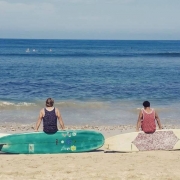“Jaltemba” the Hawksbill: One Month after Her Rescue

In the last update on Jaltemba, we had just received the permits to move her to the research centre CIIDIR-IPN in Guasave Sinaloa (Centro Interdisciplinario de Investigación para el Desarrollo Integral Regional del Instituto Politécnico Nacional), where we hoped to remove the hook from her throat and rehabilitate her for release.
That was 20 days ago, so what’s happened since? Well I am very pleased to say that Jaltemba is on the road to recovery!
When Jaltemba and I arrived at the CIIDIR-IPN, she was taken immediately for an x-ray and we were shocked to see the large size of the hook stuck deep in her throat. It became clear that removing it would not be a routine procedure.
It was now the 14th of May, 15 days since the small Hawksbill had been handed in to the Red Tortuguera A.C. Although she was being tube fed, she had lost weight. It was now or never.
We hope to track Jaltemba’s movements upon release using a satellite transmitter. This would help us to see how she does on returning to the sea. So little is known about Hawksbills in the Mexican Pacific, and Jaltemba gives us an opportunity to learn about their habits which in turn would help the regional conservation projects. The transmitter costs $16,000 pesos and the satellite time is $30,000 pesos for a year. We have a month to raise the money for this equipment to follow Jaltemba during her return to the Jaltemba Bay and beyond.
I would like to highlight that over the last month this small Hawksbill has managed (if unwillingly) to attract more attention to the critical situation that sea turtles face in our region than I have managed to do in 9 years of conservation efforts. I think this highlights the fact that it is no lie when we say “every sea turtle counts.”
Lastly, I would like to thank the authorities SEMARNAT and PROFEPA who facilitated all the permits needed to save Jaltemba; M. en C. Alan Zavala who quickly arranged things at the research centre for Jaltemba’s arrival, helped remove the hook and continues to look after her; and M. en C. Paula Claussell, MVZ Jesús Pineda, MVZ Roy Quintero, Irvin González and Dr. Alonso Aguirre who all gave up their time to help save Jaltemba. Also many thanks to the CIIDIR-IPN and all the students and staff of the wildlife department.
Finally, I would like to thank all who have followed Jaltemba’s story and I hope to see you all at her release in July (8th of July to be confirmed) in the Jaltemba Bay, Rincon de Guayabitos, Nayarit.
For more information or to help fund Jaltemba’s transmitter and satellite costs, contact Catherine E. Hart at catherine.in.guayabitos@hotmail.com or drop donations off at Hotel Peñamar in Rincon de Guayabitos. And be sure to stay tuned to JaltembaBayLife.com for future updates.
Written by Catherine E. Hart for JaltembaBayLife.com. Feel free to share or republish this story, but please give credit to JaltembaBayLife.com and/or add a link to the original story.











Leave a Reply
Want to join the discussion?Feel free to contribute!